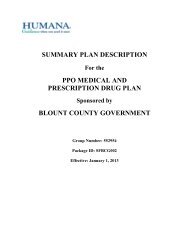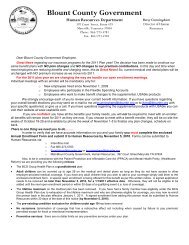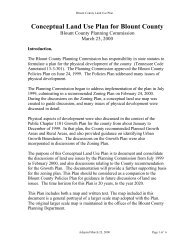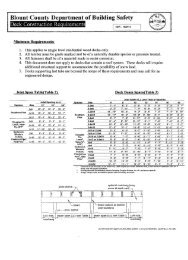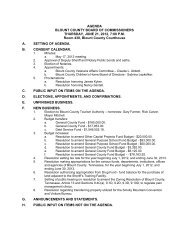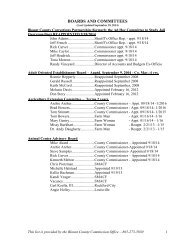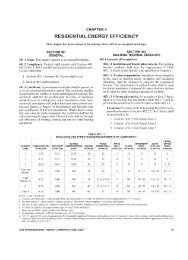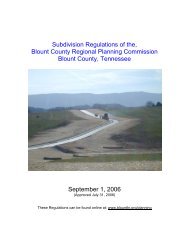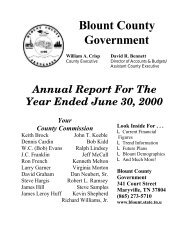Reflections on the 1101 Process in Blount County, Tennessee
Reflections on the 1101 Process in Blount County, Tennessee
Reflections on the 1101 Process in Blount County, Tennessee
Create successful ePaper yourself
Turn your PDF publications into a flip-book with our unique Google optimized e-Paper software.
Observati<strong>on</strong>s and <str<strong>on</strong>g>Reflecti<strong>on</strong>s</str<strong>on</strong>g> <strong>on</strong> <strong>the</strong> <strong>1101</strong> Growth Plann<strong>in</strong>g <strong>Process</strong><strong>in</strong> <strong>Blount</strong> <strong>County</strong>, <strong>Tennessee</strong>by John Lamb – Director, <strong>Blount</strong> <strong>County</strong> Plann<strong>in</strong>g DepartmentOctober 16, 2000Background: The author was Director of Plann<strong>in</strong>g for <strong>Blount</strong> <strong>County</strong>, <strong>Tennessee</strong> dur<strong>in</strong>g<strong>the</strong> process of formulat<strong>in</strong>g a growth plan under provisi<strong>on</strong>s of Public Chapter <strong>1101</strong>, fromSeptember 1998 to July 2000. This paper presents observati<strong>on</strong>s and reflecti<strong>on</strong>s <strong>on</strong> <strong>the</strong>process and <strong>the</strong> c<strong>on</strong>tent of <strong>the</strong> growth plan dur<strong>in</strong>g that time period. The observati<strong>on</strong>s andreflecti<strong>on</strong>s are from a county plann<strong>in</strong>g perspective.Public Chapter <strong>1101</strong> was made law by <strong>the</strong> state legislature <strong>in</strong> May of 1998. The lawrequired that <strong>the</strong> county form a Coord<strong>in</strong>at<strong>in</strong>g Committee, and formulate at least a mapshow<strong>in</strong>g Urban Growth Boundaries (UGBs), Planned Growth Area (PGA) and RuralArea (RA). Urban Growth Boundaries were to delimit areas around towns and citieswhere a reas<strong>on</strong>able pers<strong>on</strong> would expect to f<strong>in</strong>d a high level of urban <strong>in</strong>frastructure, andthus high density of development <strong>in</strong> <strong>the</strong> future. Planned Growth Area was to delimit areaoutside UGBs where a reas<strong>on</strong>able pers<strong>on</strong> would expect to f<strong>in</strong>d some higher level of<strong>in</strong>frastructure, and thus moderate to high density of development <strong>in</strong> <strong>the</strong> future. RuralArea was <strong>the</strong> rema<strong>in</strong>der of land <strong>in</strong> <strong>the</strong> county where moderate to low density ofdevelopment would be expected.Although <strong>the</strong> law was primarily <strong>in</strong>tended to address issues of annexati<strong>on</strong>, some plann<strong>in</strong>gc<strong>on</strong>tent was identified. The various UGBs, PGA and RA were to show some relati<strong>on</strong> toprojected populati<strong>on</strong> growth with<strong>in</strong> a 20 year time frame. The boundaries and areas werealso to benefit from analysis of <strong>the</strong> physical and development situati<strong>on</strong> with<strong>in</strong> <strong>the</strong> county,and c<strong>on</strong>sider plans for <strong>in</strong>frastructure improvements. Lastly, <strong>the</strong> overall plan was to take<strong>in</strong>to c<strong>on</strong>siderati<strong>on</strong> <strong>the</strong> effects of sprawl, and to address issues of preservati<strong>on</strong>.The growth plan process was <strong>in</strong>tended to br<strong>in</strong>g all governmental parties to <strong>the</strong> same tablefor a cooperative effort. Also <strong>in</strong>cluded at <strong>the</strong> table were selected representatives fromvarious <strong>in</strong>terests, <strong>in</strong>clud<strong>in</strong>g school systems, utility providers, homeowners, developers,farmers and c<strong>on</strong>servati<strong>on</strong>ists. The Coord<strong>in</strong>at<strong>in</strong>g Committee, made up of <strong>the</strong>se members,was to formulate a growth plan for <strong>the</strong> county, to <strong>the</strong>n be acted up<strong>on</strong> by each locallegislative body with<strong>in</strong> <strong>the</strong> county. Each legislative body had power of veto over <strong>the</strong>plan. In case of an impasse, with <strong>on</strong>e or more legislative bodies veto<strong>in</strong>g <strong>the</strong> plan, a statelevel mechanism for mediati<strong>on</strong> and arbitrati<strong>on</strong> was provided <strong>in</strong> <strong>the</strong> law.Early Impressi<strong>on</strong>s: Public Chapter <strong>1101</strong> was heralded by <strong>the</strong> plann<strong>in</strong>g community <strong>in</strong><strong>the</strong> state as landmark legislati<strong>on</strong>. Local expectati<strong>on</strong> with<strong>in</strong> <strong>the</strong> <strong>County</strong> Government wasthat <strong>the</strong> law would place <strong>the</strong> <strong>County</strong> <strong>on</strong> a more equal foot<strong>in</strong>g <strong>in</strong> relati<strong>on</strong> to towns andcities. This expectati<strong>on</strong> was particularly relevant to provisi<strong>on</strong>s <strong>in</strong> <strong>the</strong> law for morepredictable revenue streams to <strong>the</strong> <strong>County</strong> <strong>in</strong> <strong>the</strong> event of annexati<strong>on</strong>. In additi<strong>on</strong>, <strong>the</strong><strong>County</strong> expected that cities and towns would be required to identify reas<strong>on</strong>able bases forareas of future annexati<strong>on</strong> and extraterritorial plann<strong>in</strong>g.<strong>Blount</strong> <strong>County</strong> <strong>1101</strong> Growth Plann<strong>in</strong>g <strong>Process</strong> Page 1 of 14
Maryville appo<strong>in</strong>tment of <strong>the</strong> plann<strong>in</strong>g commissi<strong>on</strong> member may be seen as be<strong>in</strong>gassociated with both city and county governments. The rema<strong>in</strong>der were nom<strong>in</strong>ally<strong>in</strong>dependent. The county government was thus a dist<strong>in</strong>ct m<strong>in</strong>ority <strong>in</strong> representati<strong>on</strong> <strong>on</strong><strong>the</strong> Coord<strong>in</strong>at<strong>in</strong>g Committee.Populati<strong>on</strong> Projecti<strong>on</strong>s: One of <strong>the</strong> basic plann<strong>in</strong>g <strong>in</strong>puts required by Public Chapter<strong>1101</strong> was populati<strong>on</strong> projecti<strong>on</strong>s. Projecti<strong>on</strong>s were provided by <strong>the</strong> University of<strong>Tennessee</strong> (UT). The local governments were given <strong>the</strong> opportunity to c<strong>on</strong>test <strong>the</strong>projecti<strong>on</strong>s, and to provide alternative figures for <strong>the</strong> <strong>1101</strong> process.The UT projecti<strong>on</strong>s (all rounded to nearest 100) showed <strong>Blount</strong> <strong>County</strong> grow<strong>in</strong>g to124,000 by <strong>the</strong> year 2020. The county c<strong>on</strong>tested <strong>the</strong> projecti<strong>on</strong>s, supply<strong>in</strong>g its ownprojected populati<strong>on</strong> of 136,000. The City of Alcoa was projected by UT to grow to8,800 by <strong>the</strong> year 2020. The City of Alcoa also c<strong>on</strong>tested <strong>the</strong> UT projecti<strong>on</strong>s, supply<strong>in</strong>gits own projected populati<strong>on</strong> of 15,000. The o<strong>the</strong>r towns and cities accepted <strong>the</strong> UTprojecti<strong>on</strong>s as follows: Maryville – 32,600; Louisville – 1,800; Friendsville – 1,300;Rockford 1,000; and Townsend – 600. Based <strong>on</strong> locally accepted projecti<strong>on</strong>s, <strong>the</strong> cityproporti<strong>on</strong> of populati<strong>on</strong> was expected to grow from about 35 percent <strong>in</strong> <strong>the</strong> year 2000 toabout 38 percent <strong>in</strong> <strong>the</strong> year 2020.Populati<strong>on</strong> Density: Populati<strong>on</strong> density was a major def<strong>in</strong><strong>in</strong>g characteristic of <strong>the</strong> threegrowth plan areas, with Urban Growth Boundaries be<strong>in</strong>g projected high densitydevelopment, Planned Growth Area be<strong>in</strong>g projected moderate to high density, and RuralArea be<strong>in</strong>g projected low to moderate density. Public Chapter <strong>1101</strong> did not provideguidance <strong>on</strong> how density would be applied at <strong>the</strong> local level. It was assumed that eachlocality would need to def<strong>in</strong>e density categories for local plann<strong>in</strong>g applicati<strong>on</strong>.There was no formal agreement <strong>on</strong> what high, moderate and low density developmentwas <strong>in</strong> <strong>Blount</strong> <strong>County</strong> for <strong>the</strong> purpose of def<strong>in</strong><strong>in</strong>g <strong>the</strong> three required areas. The generalc<strong>on</strong>sensus held that areas of high density development would be def<strong>in</strong>ed by reference to ahigh level of urban services, most particularly sewer. The <strong>County</strong> offered its ownanalysis of density categories based <strong>on</strong> criteria for approval of subdivisi<strong>on</strong>s <strong>in</strong> <strong>the</strong> countyplann<strong>in</strong>g commissi<strong>on</strong>.High density was def<strong>in</strong>ed <strong>in</strong> relati<strong>on</strong> to provisi<strong>on</strong> of sewer, which would allowsubdivisi<strong>on</strong> densities greater than 1.5 units per acre. Note that under <strong>County</strong> regulati<strong>on</strong>s<strong>the</strong> maximum density <strong>on</strong> sewer was about 4.6 units per acre, under Maryville regulati<strong>on</strong>s<strong>the</strong> maximum density was 6.2 units per acre, and under Alcoa regulati<strong>on</strong>s <strong>the</strong> maximumdensity exceeded 12 units per acre.Moderate density was def<strong>in</strong>ed as a range from <strong>on</strong>e unit per three acres to 1.5 units peracre. This was based <strong>on</strong> <strong>in</strong>formal observati<strong>on</strong> that most n<strong>on</strong>-mounta<strong>in</strong>ous development<strong>in</strong> <strong>the</strong> county <strong>on</strong> septic systems was with<strong>in</strong> that density range. The standard fordevelopment <strong>on</strong> <strong>in</strong>dividual septic systems was similar across all jurisdicti<strong>on</strong>s, be<strong>in</strong>g am<strong>in</strong>imum lot size of between 20,000 to 25,000 square feet if <strong>on</strong> public water.<strong>Blount</strong> <strong>County</strong> <strong>1101</strong> Growth Plann<strong>in</strong>g <strong>Process</strong> Page 3 of 14
Low density was def<strong>in</strong>ed as any density less than <strong>on</strong>e unit per three acres. This was <strong>the</strong>norm for development <strong>in</strong> <strong>the</strong> more remote and mounta<strong>in</strong>ous areas of <strong>the</strong> county wheredevelopment c<strong>on</strong>stra<strong>in</strong>ts were most severe, sewer was not available, public water wasoften not available, and o<strong>the</strong>r public <strong>in</strong>frastructure such as roads were lessaccommodat<strong>in</strong>g.Land Needed for Growth <strong>in</strong> <strong>the</strong> <strong>County</strong>: Identify<strong>in</strong>g area needed for growth requiresat a m<strong>in</strong>imum a relati<strong>on</strong> between density and projected demand. In <strong>the</strong> local <strong>1101</strong>process, <strong>the</strong> <strong>County</strong> ultimately accepted <strong>the</strong> density c<strong>on</strong>versi<strong>on</strong> factor of <strong>on</strong>e householdper acre for urban density (an average <strong>in</strong>clusive of all land uses and open space) asoffered by <strong>the</strong> City of Maryville (see also below regard<strong>in</strong>g <strong>the</strong> Maryville proposal forUGB). Projected demand was based <strong>on</strong> <strong>the</strong> populati<strong>on</strong> projecti<strong>on</strong>s accepted by allparticipants.The <strong>County</strong> assumed a projected populati<strong>on</strong> between 124,000 and 136,000 by <strong>the</strong> year2020. This would give a projected populati<strong>on</strong> growth of between 22,000 and 32,000pers<strong>on</strong>s over 20 years. Assum<strong>in</strong>g a c<strong>on</strong>versi<strong>on</strong> of 2.5 pers<strong>on</strong>s per household, <strong>the</strong>re wouldbe a projected 8,800 to 12,800 new households <strong>in</strong> <strong>the</strong> county by <strong>the</strong> year 2020.Us<strong>in</strong>g <strong>the</strong> c<strong>on</strong>versi<strong>on</strong> factor of <strong>on</strong>e household per acre for average urban density, 14 to 20square miles would be needed to accommodate future growth <strong>in</strong> <strong>the</strong> entire county ifdeveloped at urban density. This was used as <strong>on</strong>e benchmark for judg<strong>in</strong>g <strong>the</strong>reas<strong>on</strong>ableness of proposals for Urban Growth Boundaries.Small Town Urban Growth Boundary Proposals: The four small towns had vary<strong>in</strong>gapproaches to identify<strong>in</strong>g Urban Growth Boundaries. N<strong>on</strong>e were able to rely <strong>on</strong>extensi<strong>on</strong> of sewer. This lack of basic urban <strong>in</strong>frastructure should have limited <strong>the</strong>identificati<strong>on</strong> of UGBs by <strong>the</strong> small towns. Such was not <strong>the</strong> case.Louisville. The town of Louisville had a land area of about 10 square miles. With apopulati<strong>on</strong> of 1,500, <strong>the</strong> populati<strong>on</strong> density was 150 pers<strong>on</strong>s per square mile, or about 0.1households per acre. Most of <strong>the</strong> <strong>in</strong>corporated municipal area was characterized as rural.The representative <strong>on</strong> <strong>the</strong> Coord<strong>in</strong>at<strong>in</strong>g Committee <strong>in</strong>itially requested that Louisville bedeclared a rural area <strong>in</strong> order to preserve <strong>the</strong> character of <strong>the</strong> town.The town of Louisville had a history of c<strong>on</strong>flict with <strong>the</strong> City of Alcoa. Louisville was<strong>in</strong>corporated <strong>in</strong> 1990 <strong>in</strong> reacti<strong>on</strong> to moves by <strong>the</strong> City of Alcoa to extend regulati<strong>on</strong> <strong>in</strong> itsextraterritorial plann<strong>in</strong>g regi<strong>on</strong> and to annex far from <strong>the</strong> urban center. Citizens of <strong>the</strong>future town c<strong>on</strong>ducted a successful campaign to <strong>in</strong>corporate large areas of ma<strong>in</strong>ly ruralland to stave off <strong>the</strong> <strong>in</strong>roads of <strong>the</strong> larger city. In <strong>the</strong> recent past, <strong>the</strong> two municipalitieswent to court to settle disputed annexati<strong>on</strong>s. Part of <strong>the</strong> legal settlement was a def<strong>in</strong>edboundary bey<strong>on</strong>d which Alcoa would not annex <strong>in</strong> <strong>the</strong> future. Louisville used thatboundary as part of <strong>the</strong> justificati<strong>on</strong> for its Urban Growth Boundary proposal.In additi<strong>on</strong>, early maps of <strong>the</strong> UGB for Louisville identified a much larger area outside<strong>the</strong> agreements with Alcoa. Louisville and Friendsville <strong>in</strong>formally jo<strong>in</strong>ed <strong>in</strong> a strategy to<strong>Blount</strong> <strong>County</strong> <strong>1101</strong> Growth Plann<strong>in</strong>g <strong>Process</strong> Page 4 of 14
divide <strong>the</strong> northwest porti<strong>on</strong> of <strong>the</strong> county between <strong>the</strong>m. The <strong>County</strong> resisted thispartiti<strong>on</strong>. The author visited <strong>the</strong> Louisville Plann<strong>in</strong>g Commissi<strong>on</strong> and maderepresentati<strong>on</strong> that such a large area of ma<strong>in</strong>ly rural land could not be justified underprovisi<strong>on</strong>s of <strong>the</strong> <strong>1101</strong> law. Louisville aband<strong>on</strong>ed <strong>the</strong>ir plan for this expanded area.The f<strong>in</strong>al plan for <strong>the</strong> Louisville UGB relied ma<strong>in</strong>ly <strong>on</strong> <strong>the</strong> legal settlement with Alcoa.The area identified encompassed about 4 square miles. The <strong>County</strong> rejected <strong>the</strong> f<strong>in</strong>alplan for Louisville <strong>on</strong> several counts. First, projected populati<strong>on</strong> <strong>in</strong>dicated a need forurban density development of less than <strong>on</strong>e square mile. Sec<strong>on</strong>d, <strong>the</strong> avowed goal ofLouisville to encourage rural density development was not c<strong>on</strong>sistent with <strong>the</strong> provisi<strong>on</strong>sof <strong>the</strong> <strong>1101</strong> law, and <strong>the</strong>re was a substantial amount of area with<strong>in</strong> <strong>the</strong> present corporatelimits that could accommodate <strong>the</strong> projected populati<strong>on</strong> <strong>in</strong>crease. Third, <strong>the</strong> county wasnot a party to <strong>the</strong> agreement between <strong>the</strong> town and <strong>the</strong> City of Alcoa <strong>on</strong> annexati<strong>on</strong>, andwas thus not bound by that agreement. Lastly, and most importantly, Louisville did nothave capability to provide sewer which was necessary to encourage high density urbangrowth. The <strong>County</strong> <strong>in</strong>dicated that it would accept an Urban Growth Boundaryencompass<strong>in</strong>g <strong>on</strong>ly 1.3 square miles.Friendsville. The town of Friendsville had a land area of about 3 square miles. With apopulati<strong>on</strong> of 1,000, <strong>the</strong> populati<strong>on</strong> density was 333 pers<strong>on</strong>s per square mile, or about 0.2households per acre. Friendsville could be characterized as an older town clustersurrounded by rural density development, and a potential commercial corridor al<strong>on</strong>g amajor highway.The town of Friendsville had a recent history of c<strong>on</strong>cern with expansi<strong>on</strong> by <strong>the</strong> City ofMaryville. The two municipalities met at a l<strong>in</strong>e al<strong>on</strong>g a major highway. Therepresentatives from Friendsville <strong>in</strong>dicated that <strong>on</strong>e of <strong>the</strong>ir ma<strong>in</strong> c<strong>on</strong>cerns <strong>in</strong> identify<strong>in</strong>gan Urban Growth Boundary was to forestall Maryville annex<strong>in</strong>g around parts of <strong>the</strong> town.In additi<strong>on</strong>, as noted above, Friendsville and Louisville came to an early <strong>in</strong>formalagreement to partiti<strong>on</strong> <strong>the</strong> northwest porti<strong>on</strong> of <strong>the</strong> county between <strong>the</strong>mselves. Thecounty resisted this move <strong>in</strong> similar fashi<strong>on</strong> as with Louisville. The plan for a greatlyexpanded UGB was dropped by <strong>the</strong> town.The area identified as <strong>the</strong> Friendsville UGB encompassed about 2 square miles. The<strong>County</strong> rejected <strong>the</strong> f<strong>in</strong>al plan for Friendsville <strong>on</strong> two ma<strong>in</strong> counts. First, projectedpopulati<strong>on</strong> <strong>in</strong>dicated a need for urban density development of less than <strong>on</strong>e square mile.Sec<strong>on</strong>d, and most importantly, Friendsville did not have capability to provide sewer thatwas necessary to encourage high density urban growth. The <strong>County</strong> <strong>in</strong>dicated that itwould accept an Urban Growth Boundary encompass<strong>in</strong>g <strong>on</strong>ly 0.7 square miles.Rockford. The town of Rockford had a land area of about 3 square miles. With apopulati<strong>on</strong> of 800, <strong>the</strong> populati<strong>on</strong> density was 267 pers<strong>on</strong>s per square mile, or about 0.17households per acre. Rockford could be characterized as an older town clustersurrounded by rural density development, and with a potential development corridoral<strong>on</strong>g a m<strong>in</strong>or arterial road.<strong>Blount</strong> <strong>County</strong> <strong>1101</strong> Growth Plann<strong>in</strong>g <strong>Process</strong> Page 5 of 14
The town of Rockford had a recent history of c<strong>on</strong>flict with <strong>the</strong> City of Alcoa. In <strong>the</strong>recent past, <strong>the</strong> two municipalities went to court to settle disputed annexati<strong>on</strong>s. Part of<strong>the</strong> legal settlement was a def<strong>in</strong>ed boundary bey<strong>on</strong>d which Alcoa would not annex <strong>in</strong> <strong>the</strong>future. Rockford used that boundary as part of <strong>the</strong> justificati<strong>on</strong> for its Urban GrowthBoundary proposal.Rockford proposed a modest Urban Growth Boundary encompass<strong>in</strong>g less than 2 squaremiles. While <strong>the</strong> <strong>County</strong> recognized that <strong>the</strong>re was little justificati<strong>on</strong> for true urban typeof growth without <strong>the</strong> provisi<strong>on</strong> of sewer, <strong>the</strong> <strong>County</strong> accepted that <strong>the</strong> town did not try toidentify an overly large area. In additi<strong>on</strong>, <strong>the</strong>re was some provisi<strong>on</strong> of sewer by anoutside utility <strong>in</strong>to part of <strong>the</strong> proposed UGB, and some possibility for extensi<strong>on</strong> of sewer<strong>in</strong> <strong>the</strong> future. The <strong>County</strong> accepted <strong>the</strong> Rockford proposal as reas<strong>on</strong>able.Townsend. The town of Townsend had a land area of about 1 square mile at <strong>the</strong>beg<strong>in</strong>n<strong>in</strong>g of <strong>the</strong> <strong>1101</strong> process. With a populati<strong>on</strong> of 450, <strong>the</strong> populati<strong>on</strong> density was 450pers<strong>on</strong>s per square mile, or about 0.28 households per acre. Townsend could becharacterized as a town cluster surrounded by a mix of tourist development and ruraldensity development. The tourist development centered <strong>on</strong> a major highway, and wasrelated to <strong>the</strong> gateway status of <strong>the</strong> town to <strong>the</strong> Great Smoky Mounta<strong>in</strong>s Nati<strong>on</strong>al Park.Dur<strong>in</strong>g <strong>the</strong> process of <strong>1101</strong> deliberati<strong>on</strong>s, <strong>the</strong> town annexed a little less than 1 squaremile. This area was part of <strong>the</strong> town’s <strong>in</strong>itial identificati<strong>on</strong> of an UGB. The rema<strong>in</strong>der of<strong>the</strong> <strong>in</strong>itial UGB amounted to about ano<strong>the</strong>r 1 square mile. All of <strong>the</strong> area was centered <strong>on</strong><strong>the</strong> major highway that identified a present and potential commercial corridor for touristoriented development. The <strong>County</strong> accepted this corridor based UGB, even though <strong>the</strong>town could not provide sewer service.There were some c<strong>on</strong>fus<strong>in</strong>g messages from <strong>the</strong> Townsend representatives as <strong>the</strong> <strong>1101</strong>process progressed. At first, <strong>the</strong>re was an <strong>in</strong>dicati<strong>on</strong> that <strong>the</strong> modest corridor UGB wouldbe acceptable. About mid-way through <strong>the</strong> process, <strong>the</strong> mayor <strong>in</strong>dicated that anexpanded UGB was be<strong>in</strong>g c<strong>on</strong>sidered. This was never presented formally to <strong>the</strong>Coord<strong>in</strong>at<strong>in</strong>g Committee. At <strong>the</strong> last meet<strong>in</strong>g of <strong>the</strong> Coord<strong>in</strong>at<strong>in</strong>g Committee, afterformal acti<strong>on</strong> had already been taken <strong>on</strong> <strong>the</strong> f<strong>in</strong>al growth plan for <strong>the</strong> county, a newrepresentative for <strong>the</strong> town announced that a much expanded UGB should have beenpresented. The <strong>County</strong> <strong>in</strong>dicated that such an expanded area was not acceptable. TheCoord<strong>in</strong>at<strong>in</strong>g Committee did not accept <strong>the</strong> late proposal.The City of Alcoa Urban Growth Boundary Proposal: The City of Alcoa had a landarea of about 13.5 square miles. With a populati<strong>on</strong> of 8,000, <strong>the</strong> populati<strong>on</strong> density was592 pers<strong>on</strong>s per square mile, or about 0.37 households per acre. Alcoa could becharacterized as a major commercial and <strong>in</strong>dustrial center of <strong>the</strong> county, center<strong>in</strong>g <strong>on</strong>major highway routes <strong>in</strong>to and out of <strong>the</strong> county. The proporti<strong>on</strong> of commercial toresidential land was skewed to commercial when compared to o<strong>the</strong>r municipalities. Thecity had substantial areas of buffer land around <strong>the</strong> major <strong>in</strong>dustry of <strong>the</strong> Alum<strong>in</strong>um<strong>Blount</strong> <strong>County</strong> <strong>1101</strong> Growth Plann<strong>in</strong>g <strong>Process</strong> Page 6 of 14
Company of America (ALCOA), had substantial land held vacant by <strong>the</strong> ALCOA, andhad recently annexed a large prospective commercial area which was not yet developed.The City of Alcoa had an extraterritorial plann<strong>in</strong>g regi<strong>on</strong> of l<strong>on</strong>g stand<strong>in</strong>g. The city hadbeen exercis<strong>in</strong>g subdivisi<strong>on</strong> regulati<strong>on</strong>s for about three decades with<strong>in</strong> <strong>the</strong> plann<strong>in</strong>gregi<strong>on</strong>, and had <strong>in</strong>stituted z<strong>on</strong><strong>in</strong>g <strong>in</strong> <strong>the</strong> early 1990’s. The town of Louisville hadannexed substantial porti<strong>on</strong>s of <strong>the</strong> western secti<strong>on</strong> of <strong>the</strong> plann<strong>in</strong>g regi<strong>on</strong> s<strong>in</strong>ce <strong>the</strong> early1990’s, leav<strong>in</strong>g an extraterritorial area of about 18 square miles. With<strong>in</strong> that regi<strong>on</strong>, <strong>the</strong>city had annexed extensively al<strong>on</strong>g roads, railroads, and waterways. The city had alsoextended sewer <strong>on</strong> its own <strong>in</strong>itiative <strong>in</strong>to <strong>the</strong> more developed porti<strong>on</strong>s of <strong>the</strong> plann<strong>in</strong>gregi<strong>on</strong>, particularly <strong>in</strong> <strong>the</strong> commercializ<strong>in</strong>g area around a new <strong>in</strong>terstate highway l<strong>in</strong>k<strong>in</strong>g<strong>the</strong> town with <strong>the</strong> large City Knoxville to <strong>the</strong> north <strong>in</strong> adjacent Knox <strong>County</strong>.The City of Alcoa identified an area of about 16 square miles as its Urban GrowthBoundary. This area was <strong>the</strong> old plann<strong>in</strong>g regi<strong>on</strong> not disturbed by annexati<strong>on</strong>s ofLouisville and not subject to a separate legal agreement with <strong>the</strong> city of Louisvillelimit<strong>in</strong>g annexati<strong>on</strong>s between <strong>the</strong> two municipalities.The <strong>County</strong> accepted that Alcoa was capable of provid<strong>in</strong>g sewer over <strong>the</strong> l<strong>on</strong>g termwith<strong>in</strong> much of its proposed Urban Growth Boundary, and that it had shown appropriate<strong>in</strong>itiative <strong>in</strong> extend<strong>in</strong>g sewer to new high density development with<strong>in</strong> its plann<strong>in</strong>g regi<strong>on</strong><strong>in</strong> <strong>the</strong> recent past. Based <strong>on</strong> acceptance of populati<strong>on</strong> projecti<strong>on</strong>s supplied by <strong>the</strong> city andus<strong>in</strong>g <strong>the</strong> c<strong>on</strong>versi<strong>on</strong> of <strong>on</strong>e household per acre <strong>on</strong> average for urban density growth, <strong>the</strong><strong>County</strong> calculated that Alcoa would need about 4 square miles for an Urban GrowthBoundary area. The <strong>County</strong> took two approaches <strong>in</strong> identify<strong>in</strong>g an area larger than thisbase m<strong>in</strong>imum.First, <strong>the</strong> <strong>County</strong> reduced <strong>the</strong> proposed 16 square mile UGB by exclud<strong>in</strong>g specific areaswhere provisi<strong>on</strong> of sewer was ei<strong>the</strong>r not feasible <strong>in</strong> <strong>the</strong> 20 year time horiz<strong>on</strong> of <strong>the</strong> <strong>1101</strong>law, or was not appropriate given o<strong>the</strong>r c<strong>on</strong>siderati<strong>on</strong>s. One area of about 2.5 squaremiles was of such rugged terra<strong>in</strong> that sewer with<strong>in</strong> <strong>the</strong> 20 year time horiz<strong>on</strong> was notc<strong>on</strong>sidered feasible. Ano<strong>the</strong>r area of about 1 square mile was oriented to <strong>the</strong> Little Riverand was not c<strong>on</strong>sidered as appropriate for high density development. Ano<strong>the</strong>r area ofabout 0.5 square miles had limited <strong>in</strong>frastructure, particularly roads, and was c<strong>on</strong>sideredas more appropriate for rural designati<strong>on</strong>. The last area was a unique regi<strong>on</strong>al asset <strong>in</strong> <strong>the</strong>McGhee Tys<strong>on</strong> Airport, owned and operated as a municipal airport by <strong>the</strong> City ofKnoxville. The airport was c<strong>on</strong>sidered as a self regulat<strong>in</strong>g entity and an extensi<strong>on</strong> of aseparate governmental entity. The airport also generated a substantial amount of sales taxrevenue for <strong>the</strong> <strong>County</strong>. The area of <strong>the</strong> airport was about 2 square miles.Sec<strong>on</strong>d, <strong>the</strong> <strong>County</strong> accepted that uncerta<strong>in</strong>ty <strong>in</strong> address<strong>in</strong>g market forces would require a“cushi<strong>on</strong>” of area to more reas<strong>on</strong>ably address growth. This was standard methodologyfor identify<strong>in</strong>g such areas (see for example “Stay<strong>in</strong>g Inside <strong>the</strong> L<strong>in</strong>es” by V. Gail Easley,PAS 440, American Plann<strong>in</strong>g Associati<strong>on</strong>.) The county thus accepted an area of 9.7square miles as an appropriate area for an Urban Growth Boundary for <strong>the</strong> City of Alcoa,be<strong>in</strong>g more than double <strong>the</strong> m<strong>in</strong>imum based <strong>on</strong> populati<strong>on</strong> projecti<strong>on</strong>s. This acceptance<strong>Blount</strong> <strong>County</strong> <strong>1101</strong> Growth Plann<strong>in</strong>g <strong>Process</strong> Page 7 of 14
of a generous market factor of greater than 100 percent went bey<strong>on</strong>d what most of <strong>the</strong>plann<strong>in</strong>g literature <strong>in</strong>dicated (see for example Easley <strong>in</strong> PAS 440, page 8). The <strong>County</strong>rejected <strong>the</strong> 16 square mile UGB proposal by <strong>the</strong> city and ultimately approved by <strong>the</strong>Coord<strong>in</strong>at<strong>in</strong>g Committee.The City of Maryville Urban Growth Boundary Proposal: The City of Maryville hada land area of about 15.6 square miles. With a populati<strong>on</strong> of 24,000, <strong>the</strong> populati<strong>on</strong>density was 1,538 pers<strong>on</strong>s per square mile, or about 1 household per acre. Maryvillecould be characterized as <strong>the</strong> major residential center of <strong>the</strong> county, with also a majorc<strong>on</strong>centrati<strong>on</strong> of commercial and <strong>in</strong>dustrial activity.The City of Maryville had an extraterritorial plann<strong>in</strong>g regi<strong>on</strong> of l<strong>on</strong>g stand<strong>in</strong>g. The cityhad been exercis<strong>in</strong>g subdivisi<strong>on</strong> regulati<strong>on</strong>s for about three decades with<strong>in</strong> <strong>the</strong> plann<strong>in</strong>gregi<strong>on</strong>, and had <strong>in</strong>stituted z<strong>on</strong><strong>in</strong>g <strong>in</strong> <strong>the</strong> early 1990’s. With<strong>in</strong> <strong>the</strong> 40 square mile plann<strong>in</strong>gregi<strong>on</strong>, <strong>the</strong> city had annexed <strong>on</strong>ly modestly and compactly, an area of about 3 squaremiles <strong>in</strong> <strong>the</strong> last ten years. The city had extended sewer <strong>on</strong> its own <strong>in</strong>itiative <strong>in</strong>to verysmall porti<strong>on</strong>s of <strong>the</strong> plann<strong>in</strong>g regi<strong>on</strong>, with most sewer extensi<strong>on</strong> be<strong>in</strong>g at <strong>the</strong> <strong>in</strong>itiative ofdevelopers as land became available for development. The exist<strong>in</strong>g sewer <strong>in</strong>frastructure<strong>in</strong> <strong>the</strong> plann<strong>in</strong>g regi<strong>on</strong> was actually <strong>in</strong>troduced at <strong>the</strong> <strong>in</strong>itiative of <strong>the</strong> <strong>County</strong> to serveschools and o<strong>the</strong>r county facilities.Maryville provided <strong>the</strong> most extensive analysis <strong>in</strong> propos<strong>in</strong>g its Urban Growth Boundary,<strong>in</strong> a 34 page report cover<strong>in</strong>g a f<strong>in</strong>ancial analysis for extensi<strong>on</strong> of urban services, and apopulati<strong>on</strong> analysis with projecti<strong>on</strong>s. The <strong>County</strong> found flaws <strong>in</strong> <strong>the</strong> analysis.First, <strong>the</strong> f<strong>in</strong>ancial analysis for extensi<strong>on</strong> of urban services was based <strong>on</strong> average costwith<strong>in</strong> <strong>the</strong> exist<strong>in</strong>g city limits, and not marg<strong>in</strong>al cost of extensi<strong>on</strong> of services outside <strong>the</strong>city. This led to c<strong>on</strong>clusi<strong>on</strong>s that may be characterized as “we could do it if we wanted toand we had <strong>the</strong> m<strong>on</strong>ey”. The analysis was weak <strong>on</strong> how <strong>the</strong> m<strong>on</strong>ey would actually begenerated, and was weak <strong>in</strong> address<strong>in</strong>g if <strong>the</strong> city actually wanted to expand urban<strong>in</strong>frastructure. The analysis ignored both ec<strong>on</strong>omies and disec<strong>on</strong>omies of scale, and <strong>the</strong>problem of lumpy <strong>in</strong>puts such as schools.Sec<strong>on</strong>d, Maryville had accepted <strong>the</strong> UT projecti<strong>on</strong>s and had identified <strong>the</strong> exist<strong>in</strong>gaverage density of 1 household per acre as a norm for calculat<strong>in</strong>g land area to be annexed<strong>in</strong> <strong>the</strong> next 20 years. Although buried <strong>in</strong> a multitude of tables, it was clear that <strong>the</strong> cityexpected to “grow” by annexati<strong>on</strong> no more than about 6.6 square miles to <strong>the</strong> year 2020.However, <strong>the</strong> city <strong>in</strong>itially identified an Urban Growth Boundary encompass<strong>in</strong>g 69square miles.The <strong>County</strong> did not accept such a large UGB. The area of <strong>the</strong> UGB <strong>the</strong>n became amov<strong>in</strong>g target, as <strong>the</strong> city grappled with both <strong>the</strong> county objecti<strong>on</strong>s and <strong>in</strong>ternaldiscussi<strong>on</strong>s with<strong>in</strong> <strong>the</strong> city government <strong>on</strong> <strong>the</strong> role of growth for <strong>the</strong> city. The <strong>in</strong>ternaldiscussi<strong>on</strong>s were particularly <strong>in</strong>structive.<strong>Blount</strong> <strong>County</strong> <strong>1101</strong> Growth Plann<strong>in</strong>g <strong>Process</strong> Page 8 of 14
The city had undertaken a citizen participati<strong>on</strong> based plann<strong>in</strong>g process <strong>in</strong> <strong>the</strong> recent past,which was <strong>on</strong>go<strong>in</strong>g dur<strong>in</strong>g <strong>the</strong> <strong>1101</strong> process. Results of that general plann<strong>in</strong>g process<strong>in</strong>dicated that most city residents did not want <strong>the</strong> city to grow too fast, and that keep<strong>in</strong>g<strong>the</strong> small town character of <strong>the</strong> city was very important. One of <strong>the</strong> major c<strong>on</strong>ceptsfuel<strong>in</strong>g <strong>the</strong> <strong>in</strong>ternal discussi<strong>on</strong>s was <strong>the</strong> wish to have <strong>on</strong>ly <strong>on</strong>e high school. To do thiswith just expansi<strong>on</strong> of <strong>the</strong> exist<strong>in</strong>g high school obviously limited <strong>the</strong> expectati<strong>on</strong> forpopulati<strong>on</strong> growth. The city government also discussed how growth of <strong>the</strong> city wouldimpact costs of expand<strong>in</strong>g urban services. The c<strong>on</strong>clusi<strong>on</strong> was that <strong>the</strong> city should notgrow at a rate that would overwhelm <strong>the</strong> ability to provide schools and o<strong>the</strong>r urbanservices. The city even c<strong>on</strong>sidered a moratorium <strong>on</strong> annexati<strong>on</strong> and a limit <strong>on</strong> newbuild<strong>in</strong>g permits for <strong>the</strong> near future.Maryville began a process of chipp<strong>in</strong>g away at its <strong>in</strong>itial 69 square mile UGB with aseries of proposals which ultimately resulted <strong>in</strong> a UGB proposal encompass<strong>in</strong>g about 32square miles. The ma<strong>in</strong> argument for such an extensive UGB was that <strong>the</strong> “city wouldneed to be <strong>the</strong>re for development.”The <strong>County</strong> recognized that Maryville would probably need to grow by about 5.3 squaremiles to account for expected populati<strong>on</strong> projecti<strong>on</strong>s. The <strong>County</strong> accepted thatuncerta<strong>in</strong>ty <strong>in</strong> address<strong>in</strong>g market forces would require a “cushi<strong>on</strong>” of area to morereas<strong>on</strong>ably address growth. The county thus accepted an area of 15.4 square miles as anappropriate area for an Urban Growth Boundary for <strong>the</strong> City of Maryville, be<strong>in</strong>g almostthree times <strong>the</strong> m<strong>in</strong>imum based <strong>on</strong> populati<strong>on</strong> projecti<strong>on</strong>s. This acceptance of a generousmarket factor of greater than 100 percent went bey<strong>on</strong>d what most of <strong>the</strong> plann<strong>in</strong>gliterature <strong>in</strong>dicated (see above under discussi<strong>on</strong> for Alcoa). The <strong>County</strong> rejected <strong>the</strong> 32square mile UGB proposal by <strong>the</strong> city and ultimately approved by <strong>the</strong> Coord<strong>in</strong>at<strong>in</strong>gCommittee.The <strong>County</strong> Proposals: The <strong>County</strong> was resp<strong>on</strong>sible for identify<strong>in</strong>g Planned GrowthArea (PGA) and Rural Area (RA) under provisi<strong>on</strong>s of Public Chapter <strong>1101</strong>. The <strong>County</strong>utilized a range of analysis <strong>in</strong> identify<strong>in</strong>g <strong>the</strong>se areas, <strong>in</strong>clud<strong>in</strong>g analysis of populati<strong>on</strong>,populati<strong>on</strong> density, topography, slope, soils, geology, flood pla<strong>in</strong>s, roads, utilities,development history, and land use. Much of <strong>the</strong> analysis was <strong>the</strong> result of an <strong>on</strong>go<strong>in</strong>gplann<strong>in</strong>g process that predated <strong>the</strong> <strong>1101</strong> mandate.The Planned Growth Area was identified ma<strong>in</strong>ly based <strong>on</strong> populati<strong>on</strong> density, landdevelopment patterns, and a plan for a by-pass road around <strong>the</strong> cities of Maryville andAlcoa. The PGA encompassed about 48 square miles around <strong>the</strong> two major cities. ThePGA <strong>in</strong>cluded land that was expected to be identified as Urban Growth Boundaries by <strong>the</strong>cities. The <strong>County</strong> <strong>in</strong>itially did not accept any UGB for smaller towns. The rema<strong>in</strong>der of<strong>the</strong> county outside of <strong>the</strong> PGA and municipal limits was c<strong>on</strong>sidered as Rural Area.As <strong>the</strong> municipalities made <strong>the</strong>ir first presentati<strong>on</strong>s for <strong>the</strong>ir Urban Growth Boundaries,<strong>the</strong> reacti<strong>on</strong> by <strong>the</strong> <strong>County</strong> Legislative Body was to reject any UGB and to take an <strong>in</strong>itialstance of no urban growth. The author and <strong>the</strong> <strong>County</strong> Executive argued that this was nota defensible positi<strong>on</strong>, and that some identificati<strong>on</strong> of a reas<strong>on</strong>able growth area was<strong>Blount</strong> <strong>County</strong> <strong>1101</strong> Growth Plann<strong>in</strong>g <strong>Process</strong> Page 9 of 14
necessary under provisi<strong>on</strong>s of <strong>the</strong> law. The <strong>County</strong> f<strong>in</strong>ally settled <strong>on</strong> a strategy ofaccept<strong>in</strong>g <strong>the</strong> populati<strong>on</strong> projecti<strong>on</strong>s provided by <strong>the</strong> municipalities and apply<strong>in</strong>g <strong>the</strong>c<strong>on</strong>versi<strong>on</strong> factor of 1 household per acre for average urban density as proposed by <strong>the</strong>City of Maryville. As <strong>in</strong>dicated above, this led to an identificati<strong>on</strong> of 5.3 and 4 squaremiles of UGB for <strong>the</strong> cities of Maryville and Alcoa respectively, and very modest UGBareas for <strong>the</strong> smaller towns. The <strong>County</strong> proposed that <strong>the</strong> UGB areas for <strong>the</strong> two largestcities be c<strong>on</strong>f<strong>in</strong>ed with<strong>in</strong> <strong>the</strong> proposed Planned Growth Area. In total, <strong>the</strong> <strong>in</strong>itialidentificati<strong>on</strong> by <strong>the</strong> <strong>County</strong> of UGB area needed by <strong>the</strong> municipalities was about 10square miles, or about <strong>on</strong>e half of <strong>the</strong> area needed for all growth <strong>in</strong> <strong>the</strong> county at assumedurban density over <strong>the</strong> next 20 years.This was c<strong>on</strong>trasted with <strong>in</strong>itial municipal UGB proposals that exceeded 100 squaremiles. Maryville and some of <strong>the</strong> smaller towns began a process of scal<strong>in</strong>g back <strong>the</strong>irproposals after <strong>the</strong> <strong>County</strong> objected. Alcoa stood firm <strong>on</strong> its <strong>in</strong>itial proposal. The f<strong>in</strong>alproposal approved by <strong>the</strong> Coord<strong>in</strong>at<strong>in</strong>g Committee identified a total UGB area of about57 square miles, or almost triple <strong>the</strong> area needed for all growth <strong>in</strong> <strong>the</strong> county over <strong>the</strong>next 20 years at assumed average urban density of <strong>on</strong>e household per acre. The <strong>County</strong>did not c<strong>on</strong>sider this to be reas<strong>on</strong>able, and <strong>the</strong> <strong>County</strong> formally rejected <strong>the</strong> first plan ofCoord<strong>in</strong>at<strong>in</strong>g Committee.For rec<strong>on</strong>siderati<strong>on</strong> of <strong>the</strong> plan by <strong>the</strong> Coord<strong>in</strong>at<strong>in</strong>g Committee, <strong>the</strong> <strong>County</strong> proposed anexpanded versi<strong>on</strong> of UGBs with c<strong>on</strong>siderati<strong>on</strong> for uncerta<strong>in</strong>ties and market factors. Insummary, <strong>the</strong> <strong>County</strong> accepted modest UGBs for <strong>the</strong> small towns total<strong>in</strong>g about 5 squaremiles, accepted a market factor expanded UGB of 9.7 square miles for Alcoa, and amarket factor expanded UGB of 15.4 square miles for Maryville. This encompassed atotal f<strong>in</strong>al proposal from <strong>the</strong> <strong>County</strong> of about 30 square miles of UGB area, or about 150percent of area needed for all projected growth <strong>in</strong> <strong>the</strong> county for <strong>the</strong> next 20 years at <strong>the</strong>assumed average urban density of 1 household per acre.The f<strong>in</strong>al <strong>County</strong> proposal was not even c<strong>on</strong>sidered by <strong>the</strong> Coord<strong>in</strong>at<strong>in</strong>g Committee, and<strong>the</strong> Committee rec<strong>on</strong>firmed its <strong>in</strong>itial plan. The <strong>County</strong> Legislative Body c<strong>on</strong>sidered <strong>the</strong>plan as unreas<strong>on</strong>able and formally rejected <strong>the</strong> plan <strong>in</strong> June of 2000, declar<strong>in</strong>g animpasse.<strong>County</strong> Plann<strong>in</strong>g and <strong>1101</strong> Plann<strong>in</strong>g: The State of <strong>Tennessee</strong> has an old set ofplann<strong>in</strong>g enabl<strong>in</strong>g legislati<strong>on</strong> (<strong>Tennessee</strong> Code Annotated Title 13, Chapters 3 and 4)which <strong>the</strong> <strong>County</strong> utilized <strong>in</strong> a plann<strong>in</strong>g process predat<strong>in</strong>g and separate from PublicChapter <strong>1101</strong>. The <strong>County</strong> formally <strong>in</strong>itiated <strong>the</strong> first county-wide plann<strong>in</strong>g process <strong>in</strong>more than 20 years with resoluti<strong>on</strong> and support of <strong>the</strong> <strong>County</strong> Legislative Body <strong>in</strong> Aprilof 1996. The <strong>County</strong> pursued <strong>the</strong> process with populati<strong>on</strong> analysis, populati<strong>on</strong>projecti<strong>on</strong>s, analysis of physical factors of development, analysis of developmentpatterns, reliance <strong>on</strong> a process with str<strong>on</strong>g citizen <strong>in</strong>put, and participati<strong>on</strong> by <strong>the</strong> <strong>County</strong>Commissi<strong>on</strong> as f<strong>in</strong>al decisi<strong>on</strong> makers.In early 1997, <strong>the</strong> <strong>County</strong> undertook 17 citizen <strong>in</strong>put workshops at different sitesthroughout <strong>the</strong> county, <strong>in</strong>clud<strong>in</strong>g three sites <strong>in</strong> <strong>the</strong> cities. About 250 citizens participated<strong>Blount</strong> <strong>County</strong> <strong>1101</strong> Growth Plann<strong>in</strong>g <strong>Process</strong> Page 10 of 14
<strong>in</strong> identify<strong>in</strong>g an agenda for policy c<strong>on</strong>siderati<strong>on</strong> by answer<strong>in</strong>g two basic questi<strong>on</strong>s: whatis good about <strong>Blount</strong> <strong>County</strong> that should be preserved <strong>in</strong> <strong>the</strong> future, and what needs to bechanged <strong>in</strong> <strong>Blount</strong> <strong>County</strong> to make a better future? The results of <strong>the</strong> first round ofcitizen <strong>in</strong>put were reported back to <strong>the</strong> same 17 sites <strong>in</strong> late 1997, and about 450 citizensparticipated <strong>in</strong> ref<strong>in</strong><strong>in</strong>g a set of policy and implementati<strong>on</strong> opti<strong>on</strong>s. The policy opti<strong>on</strong>swere fur<strong>the</strong>r ref<strong>in</strong>ed, with specific attenti<strong>on</strong> to implementati<strong>on</strong>, by a select 11 memberCitizen Advisory Committee from July of 1998 to January of 1999.The results of all citizen <strong>in</strong>put workshops and a report by <strong>the</strong> Advisory Committee werec<strong>on</strong>sidered by <strong>the</strong> <strong>Blount</strong> <strong>County</strong> Plann<strong>in</strong>g Commissi<strong>on</strong>. The Plann<strong>in</strong>g Commissi<strong>on</strong>produced and approved a <strong>Blount</strong> <strong>County</strong> Policies Plan <strong>in</strong> June of 1999, with a 21 itemimplementati<strong>on</strong> agenda. One of <strong>the</strong> implementati<strong>on</strong> items was to formulate a growth planas required by Public Chapter <strong>1101</strong>.The requirements of Public Chapter <strong>1101</strong> were known to <strong>the</strong> <strong>County</strong> about six m<strong>on</strong>thsprior to <strong>the</strong> formal <strong>in</strong>itiati<strong>on</strong> of <strong>the</strong> <strong>1101</strong> process <strong>in</strong> September of 1998. Although <strong>the</strong>basic requirement of a growth plan was reflected <strong>in</strong> <strong>the</strong> Policies Plan of <strong>the</strong> <strong>County</strong>, <strong>the</strong>specifics of <strong>the</strong> <strong>1101</strong> mandate caused some uncerta<strong>in</strong>ty <strong>in</strong> <strong>the</strong> general plann<strong>in</strong>g processlead<strong>in</strong>g up to adopti<strong>on</strong> of <strong>the</strong> Policies Plan and commencement of implementati<strong>on</strong>activities. Note should be taken that formal c<strong>on</strong>siderati<strong>on</strong> of <strong>the</strong> <strong>County</strong> Policies Plan by<strong>the</strong> Plann<strong>in</strong>g Commissi<strong>on</strong> overlapped by about six m<strong>on</strong>ths <strong>the</strong> <strong>in</strong>itial meet<strong>in</strong>gs of <strong>the</strong><strong>1101</strong> Coord<strong>in</strong>at<strong>in</strong>g Committee dur<strong>in</strong>g early 1999.The <strong>1101</strong> law required c<strong>on</strong>formity of <strong>County</strong> land use decisi<strong>on</strong>s with <strong>the</strong> <strong>1101</strong> growthplan. The <strong>County</strong> had expectati<strong>on</strong>s that <strong>the</strong> <strong>1101</strong> growth plan process would result <strong>in</strong> amore reas<strong>on</strong>able del<strong>in</strong>eati<strong>on</strong> of <strong>the</strong> plann<strong>in</strong>g regi<strong>on</strong>s of <strong>the</strong> two larger cities of Alcoa andMaryville. The <strong>County</strong> was disappo<strong>in</strong>ted by <strong>the</strong> <strong>in</strong>itial discussi<strong>on</strong>s <strong>in</strong>dicat<strong>in</strong>g a stand by<strong>the</strong> cities that <strong>the</strong>y would not reduce <strong>the</strong>ir plann<strong>in</strong>g regi<strong>on</strong>s, and would possibly expandsuch regi<strong>on</strong>s under <strong>the</strong> <strong>1101</strong> law.The Policies Plan assumed that extraterritorial z<strong>on</strong><strong>in</strong>g by <strong>the</strong> two cities would besuperceded by <strong>County</strong> regulati<strong>on</strong>s as allowed by state statutes. The <strong>County</strong> made thatassumpti<strong>on</strong> clear early <strong>in</strong> <strong>the</strong> <strong>1101</strong> process. The reacti<strong>on</strong> of Maryville and Alcoarepresentatives <strong>on</strong> <strong>the</strong> Coord<strong>in</strong>at<strong>in</strong>g Committee was clearly <strong>in</strong> oppositi<strong>on</strong> to thisassumpti<strong>on</strong>. This formed a c<strong>on</strong>t<strong>in</strong>u<strong>in</strong>g po<strong>in</strong>t of c<strong>on</strong>flict between <strong>the</strong> <strong>County</strong> and <strong>the</strong> twolargest cities.The f<strong>in</strong>al <strong>1101</strong> growth plan <strong>in</strong>cluded several provisi<strong>on</strong>s bey<strong>on</strong>d just <strong>the</strong> identificati<strong>on</strong> ofUrban Growth Boundaries, Planned Growth Area, and Rural Area. These provisi<strong>on</strong>swere oriented to <strong>the</strong> th<strong>in</strong>k<strong>in</strong>g of <strong>the</strong> two larger cities, and were sec<strong>on</strong>ded by <strong>the</strong> majoritycomposed of ma<strong>in</strong>ly municipal representati<strong>on</strong>. Two of <strong>the</strong> provisi<strong>on</strong>s were as follows:“<strong>the</strong> plan <strong>in</strong>clude a provisi<strong>on</strong> that any municipality hav<strong>in</strong>g an exist<strong>in</strong>g regi<strong>on</strong>al plann<strong>in</strong>gcommissi<strong>on</strong> adm<strong>in</strong>ister<strong>in</strong>g z<strong>on</strong><strong>in</strong>g and subdivisi<strong>on</strong> regulati<strong>on</strong>s <strong>in</strong> that plann<strong>in</strong>g regi<strong>on</strong>,c<strong>on</strong>t<strong>in</strong>ue to provide for such as allowed by law”; and “<strong>the</strong> coord<strong>in</strong>at<strong>in</strong>g committee tofuncti<strong>on</strong> and be tasked to address several issues relative to well be<strong>in</strong>g of <strong>the</strong> participat<strong>in</strong>g<strong>Blount</strong> <strong>County</strong> <strong>1101</strong> Growth Plann<strong>in</strong>g <strong>Process</strong> Page 11 of 14
cities <strong>in</strong> <strong>Blount</strong> <strong>County</strong> and specifically work toward those various methods thatencourage envir<strong>on</strong>mentally sound practice of ridgetop and watershed development.”The <strong>County</strong> had <strong>in</strong>itiated implementati<strong>on</strong> activities lead<strong>in</strong>g to formulati<strong>on</strong> of a z<strong>on</strong><strong>in</strong>gplan <strong>in</strong> July 1999. The process was to <strong>the</strong> po<strong>in</strong>t of an <strong>in</strong>itial draft of z<strong>on</strong><strong>in</strong>g regulati<strong>on</strong>sand map by December of 1999. This was at <strong>the</strong> same time that <strong>the</strong> Coord<strong>in</strong>at<strong>in</strong>gCommittee approved <strong>the</strong> first growth plan, <strong>in</strong>clud<strong>in</strong>g <strong>the</strong> provisi<strong>on</strong> for c<strong>on</strong>t<strong>in</strong>ued z<strong>on</strong><strong>in</strong>gauthority by <strong>the</strong> two cities <strong>in</strong> <strong>the</strong>ir plann<strong>in</strong>g regi<strong>on</strong>s. This was seen as an attempt by <strong>the</strong>two cities to force <strong>the</strong> issue of extraterritorial z<strong>on</strong><strong>in</strong>g by requir<strong>in</strong>g c<strong>on</strong>formity of <strong>County</strong>decisi<strong>on</strong>s with <strong>the</strong> growth plan. The <strong>County</strong> objected to this provisi<strong>on</strong> <strong>in</strong> <strong>the</strong> growth plan,and made clear that it <strong>in</strong>tended to pursue adopti<strong>on</strong> of its own z<strong>on</strong><strong>in</strong>g plan which coveredall area outside city limits. This formed ano<strong>the</strong>r basis for <strong>the</strong> <strong>County</strong> reject<strong>in</strong>g <strong>the</strong> growthplan, <strong>in</strong> additi<strong>on</strong> to objecti<strong>on</strong>s relat<strong>in</strong>g to UGB areas.The <strong>County</strong> c<strong>on</strong>t<strong>in</strong>ued activities <strong>in</strong> pursuit of implement<strong>in</strong>g z<strong>on</strong><strong>in</strong>g up to f<strong>in</strong>al adopti<strong>on</strong> ofregulati<strong>on</strong>s <strong>in</strong> July 2000 (with effective date of September 1, 2000). This was at about<strong>the</strong> same time that <strong>the</strong> <strong>County</strong> formally rejected <strong>the</strong> sec<strong>on</strong>d, unmodified growth plan of<strong>the</strong> Coord<strong>in</strong>at<strong>in</strong>g Committee and declared an impasse. The z<strong>on</strong><strong>in</strong>g plan of <strong>the</strong> <strong>County</strong>benefited from analysis based <strong>on</strong> <strong>the</strong> categories of Planned Growth Area and Rural Area.The approved z<strong>on</strong><strong>in</strong>g map was c<strong>on</strong>sistent with <strong>the</strong> delimitati<strong>on</strong> of those areas by <strong>the</strong><strong>County</strong>.The o<strong>the</strong>r provisi<strong>on</strong> <strong>in</strong> <strong>the</strong> plan adopted by <strong>the</strong> Coord<strong>in</strong>at<strong>in</strong>g Committee, that <strong>the</strong>Committee itself c<strong>on</strong>t<strong>in</strong>ue to act as a plann<strong>in</strong>g body for <strong>the</strong> whole county <strong>in</strong> <strong>the</strong> future didnot f<strong>in</strong>d favor with <strong>the</strong> <strong>County</strong>. One of <strong>the</strong> underly<strong>in</strong>g assumpti<strong>on</strong> of that provisi<strong>on</strong> wasthat <strong>the</strong> <strong>County</strong> Policies Plan did not adequately address issues of watershed and ridgetopprotecti<strong>on</strong>. The <strong>County</strong> rejected this attempt to supercede <strong>the</strong> legitimate functi<strong>on</strong> of itsown Plann<strong>in</strong>g Commissi<strong>on</strong>, and saw <strong>the</strong> c<strong>on</strong>t<strong>in</strong>ued functi<strong>on</strong><strong>in</strong>g of <strong>the</strong> Coord<strong>in</strong>at<strong>in</strong>gCommittee to be <strong>on</strong>ly a pretense for c<strong>on</strong>t<strong>in</strong>ued dom<strong>in</strong>ance of municipal <strong>in</strong>terests.At <strong>the</strong> same time, <strong>the</strong> <strong>County</strong> offered to undertake bilateral and multilateral plann<strong>in</strong>gprocesses <strong>on</strong> any issues of comm<strong>on</strong> c<strong>on</strong>cern between <strong>the</strong> <strong>County</strong> and <strong>the</strong> municipalities.The <strong>County</strong> proposed that any such processes <strong>in</strong>volve exist<strong>in</strong>g plann<strong>in</strong>g structures,embodied <strong>in</strong> county and municipal plann<strong>in</strong>g commissi<strong>on</strong>s, and processes enabled byexist<strong>in</strong>g state statutes <strong>on</strong> general plann<strong>in</strong>g. This was seen as compatible with <strong>the</strong> <strong>County</strong>Policies Plan and several implementati<strong>on</strong> strategies with<strong>in</strong> that plan.Inclusi<strong>on</strong> With<strong>in</strong> <strong>the</strong> <strong>1101</strong> <strong>Process</strong>: The <strong>County</strong> plann<strong>in</strong>g process, extend<strong>in</strong>g from 1996and overlapp<strong>in</strong>g with <strong>the</strong> <strong>1101</strong> process, gave utmost importance to two pr<strong>in</strong>ciples. Onewas citizen <strong>in</strong>put, and <strong>the</strong> o<strong>the</strong>r was direct and c<strong>on</strong>t<strong>in</strong>ued <strong>in</strong>clusi<strong>on</strong> of <strong>County</strong>Commissi<strong>on</strong>ers as ultimate legislative decisi<strong>on</strong> makers. Nei<strong>the</strong>r of <strong>the</strong>se pr<strong>in</strong>ciples wereevident <strong>in</strong> <strong>the</strong> <strong>1101</strong> process.The Coord<strong>in</strong>at<strong>in</strong>g Committee operated <strong>in</strong> a manner not c<strong>on</strong>ducive to citizen <strong>in</strong>put. Noeffort was made by <strong>the</strong> Committee to formally <strong>in</strong>volve <strong>the</strong> general citizenry <strong>in</strong>deliberati<strong>on</strong>s. The <strong>on</strong>ly po<strong>in</strong>ts of citizen <strong>in</strong>put were <strong>the</strong> required formal public hear<strong>in</strong>gs<strong>Blount</strong> <strong>County</strong> <strong>1101</strong> Growth Plann<strong>in</strong>g <strong>Process</strong> Page 12 of 14
<strong>on</strong> <strong>the</strong> separate plans of <strong>the</strong> county and municipalities, and <strong>the</strong> overall plan of <strong>the</strong>Coord<strong>in</strong>at<strong>in</strong>g Committee. These public hear<strong>in</strong>gs were not well attended, and <strong>in</strong> any eventcame after <strong>the</strong> plans were formulated.In additi<strong>on</strong>, some of <strong>the</strong> Committee members advocated that municipal and countylegislators should not be <strong>in</strong>volved <strong>in</strong> <strong>the</strong> early process. The reas<strong>on</strong> given for thisresistance to legislative <strong>in</strong>clusi<strong>on</strong> was that positi<strong>on</strong>s needed to be flexible <strong>in</strong> <strong>the</strong> earlystages of <strong>the</strong> process, and <strong>in</strong>volvement of legislative representatives would lead to aharden<strong>in</strong>g of positi<strong>on</strong>s and an <strong>in</strong>fusi<strong>on</strong> of unneeded politics. The <strong>County</strong> rejected thisstance and <strong>in</strong>cluded c<strong>on</strong>t<strong>in</strong>uous c<strong>on</strong>sultati<strong>on</strong> at several levels with <strong>County</strong> Commissi<strong>on</strong>ers– at <strong>the</strong> level of <strong>the</strong> whole Commissi<strong>on</strong> for both orientati<strong>on</strong> and general discussi<strong>on</strong>, at <strong>the</strong>level of committees of <strong>the</strong> Commissi<strong>on</strong> for more detailed and <strong>on</strong>go<strong>in</strong>g orientati<strong>on</strong> anddiscussi<strong>on</strong>, and at <strong>the</strong> level of a c<strong>on</strong>sultative committee <strong>in</strong>clud<strong>in</strong>g two members of <strong>the</strong>Commissi<strong>on</strong> al<strong>on</strong>g with <strong>the</strong> <strong>County</strong> Executive, <strong>the</strong> Director of Plann<strong>in</strong>g (author) and <strong>the</strong>two members of <strong>the</strong> Coord<strong>in</strong>at<strong>in</strong>g Committee appo<strong>in</strong>ted by <strong>the</strong> <strong>County</strong> Executive.Several of <strong>the</strong> Coord<strong>in</strong>at<strong>in</strong>g Committee meet<strong>in</strong>gs were also attended by a few membersof <strong>the</strong> <strong>County</strong> Commissi<strong>on</strong>.Sprawl and Urban Services: Although ma<strong>in</strong>ly focused <strong>on</strong> issues of annexati<strong>on</strong>, PublicChapter <strong>1101</strong> also <strong>in</strong>tended to address issues of sprawl and rati<strong>on</strong>al provisi<strong>on</strong> of urbanservices. Sprawl was a popular buzz-word <strong>in</strong> <strong>the</strong> plann<strong>in</strong>g professi<strong>on</strong> at <strong>the</strong> time ofadopti<strong>on</strong> and implementati<strong>on</strong> of <strong>the</strong> law. Many f<strong>in</strong>e studies had been c<strong>on</strong>ducted,focus<strong>in</strong>g <strong>on</strong> major metropolitan areas of <strong>the</strong> country and show<strong>in</strong>g that sprawl hasnegative effects.The c<strong>on</strong>cept of sprawl seems to have been <strong>in</strong>corporated <strong>in</strong>to state legislati<strong>on</strong> withoutdef<strong>in</strong>itive study of <strong>the</strong> issue <strong>in</strong> <strong>the</strong> c<strong>on</strong>text of <strong>Tennessee</strong>. The c<strong>on</strong>cept was applied to allcounties <strong>in</strong> <strong>the</strong> state without regard to historical growth patterns and potential growthtrajectories, particularly <strong>in</strong> regards to be<strong>in</strong>g with<strong>in</strong> or without <strong>the</strong> <strong>in</strong>fluence area of a largeMSA center city.On <strong>the</strong>ir face, <strong>the</strong> areas of Urban Growth Boundaries proposed by <strong>the</strong> municipalities <strong>in</strong><strong>Blount</strong> <strong>County</strong> were <strong>in</strong>dicative of sprawl, with proposed area exceed<strong>in</strong>g needed area forprojected growth by factors of 300 to 500 percent. In additi<strong>on</strong>, n<strong>on</strong>e of <strong>the</strong> municipalplans addressed development of vacant land with<strong>in</strong> exist<strong>in</strong>g corporate limits, and did notaddress <strong>in</strong>tensificati<strong>on</strong> of development <strong>in</strong> <strong>the</strong> cities where urban services already existed.This would <strong>in</strong>dicate a status quo development pattern unc<strong>on</strong>stra<strong>in</strong>ed by c<strong>on</strong>siderati<strong>on</strong>s ofsprawl.One of <strong>the</strong> ma<strong>in</strong> weaknesses of <strong>the</strong> <strong>1101</strong> process at <strong>the</strong> local level <strong>in</strong> <strong>Blount</strong> <strong>County</strong> was<strong>the</strong> lack of detailed analysis of <strong>the</strong> relati<strong>on</strong>ship between growth and <strong>the</strong> planned provisi<strong>on</strong>of urban services. One of <strong>the</strong> most basic foundati<strong>on</strong>s of plans for services was lack<strong>in</strong>g –<strong>the</strong> capital improvements program and budget. Without c<strong>on</strong>stra<strong>in</strong>t of budget and timedprovisi<strong>on</strong> of services, municipalities were emboldened to identify unrealistic growthboundaries.<strong>Blount</strong> <strong>County</strong> <strong>1101</strong> Growth Plann<strong>in</strong>g <strong>Process</strong> Page 13 of 14
C<strong>on</strong>clusi<strong>on</strong>s: From <strong>the</strong> standpo<strong>in</strong>t of <strong>Blount</strong> <strong>County</strong>, <strong>the</strong> Public Chapter <strong>1101</strong> processwas less than satisfactory.The membership of <strong>the</strong> Coord<strong>in</strong>at<strong>in</strong>g Committee mandated by <strong>the</strong> <strong>1101</strong> law was stacked<strong>in</strong> favor of municipal <strong>in</strong>terests, to <strong>the</strong> dist<strong>in</strong>ct disadvantage <strong>in</strong> address<strong>in</strong>g legitimate<strong>County</strong> c<strong>on</strong>cerns.The law did not provide a sound basis for judg<strong>in</strong>g <strong>the</strong> reas<strong>on</strong>ableness of proposals forgrowth areas. The municipalities were thus not c<strong>on</strong>stra<strong>in</strong>ed by a c<strong>on</strong>sistently identifiableset of standards <strong>in</strong> identify<strong>in</strong>g Urban Growth Boundaries.The <strong>1101</strong> law put <strong>the</strong> <strong>County</strong> and <strong>the</strong> six municipalities <strong>in</strong>to c<strong>on</strong>flict over identify<strong>in</strong>gterritories. This was not c<strong>on</strong>ducive to cooperative and rati<strong>on</strong>al plann<strong>in</strong>g.The <strong>1101</strong> law ignored exist<strong>in</strong>g plann<strong>in</strong>g legislati<strong>on</strong> that could provide a morecomprehensive approach to growth plann<strong>in</strong>g.The <strong>1101</strong> process was not <strong>in</strong>clusive. There was little citizen <strong>in</strong>put, and local legislativedecisi<strong>on</strong> makers were not adequately <strong>in</strong>cluded <strong>in</strong> deliberati<strong>on</strong>s.The <strong>1101</strong> law did not have clear land use and development criteria for determ<strong>in</strong><strong>in</strong>gsprawl and appropriate development patterns. Status quo development patterns wereprojected <strong>in</strong>to <strong>the</strong> future.Recommendati<strong>on</strong>s: Public Chapter <strong>1101</strong> should be scaled back <strong>in</strong>to a law address<strong>in</strong>gannexati<strong>on</strong> issues. General plann<strong>in</strong>g issues should be c<strong>on</strong>sidered us<strong>in</strong>g exist<strong>in</strong>g plann<strong>in</strong>genabl<strong>in</strong>g legislati<strong>on</strong>. The exist<strong>in</strong>g plann<strong>in</strong>g statutes could be modified to <strong>in</strong>clude explicitprovisi<strong>on</strong>s for citizen participati<strong>on</strong>, and explicit requirements and standards forc<strong>on</strong>sider<strong>in</strong>g issues of growth. Mechanisms for cooperative plann<strong>in</strong>g between countiesand municipalities could be <strong>in</strong>cluded <strong>in</strong> modified plann<strong>in</strong>g legislati<strong>on</strong>, particularlyprovisi<strong>on</strong> for a county wide coord<strong>in</strong>at<strong>in</strong>g committee which would have limited powers ofcoord<strong>in</strong>ati<strong>on</strong> over <strong>in</strong>dividual plann<strong>in</strong>g commissi<strong>on</strong>s. The exist<strong>in</strong>g plann<strong>in</strong>g legislati<strong>on</strong>could be expanded to <strong>in</strong>clude specific provisi<strong>on</strong>s for capital improvement programs andbudgets to address public services needed for growth. Studies of sprawl <strong>in</strong> <strong>the</strong> c<strong>on</strong>text of<strong>Tennessee</strong> should be c<strong>on</strong>ducted prior to focus <strong>on</strong> this issue <strong>in</strong> plann<strong>in</strong>g legislati<strong>on</strong>.Particular attenti<strong>on</strong> should be given to <strong>the</strong> differences between MSA centered growth andn<strong>on</strong>-MSA growth issues.____________________Paper presented at <strong>the</strong> 42 nd Annual C<strong>on</strong>ference of <strong>the</strong> Associati<strong>on</strong> of Collegiate Schools of Plann<strong>in</strong>g,Atlanta, Georgia, November 4, 2000. This paper was presented as part of a panel discussi<strong>on</strong> <strong>in</strong> Track 6 –Land Use Policy and Governance – <strong>Tennessee</strong>’s Growth Policy Act: Report from <strong>the</strong> Trenches –moderated by Cecilia Zanetta of <strong>the</strong> University of <strong>Tennessee</strong>.<strong>Blount</strong> <strong>County</strong> <strong>1101</strong> Growth Plann<strong>in</strong>g <strong>Process</strong> Page 14 of 14





